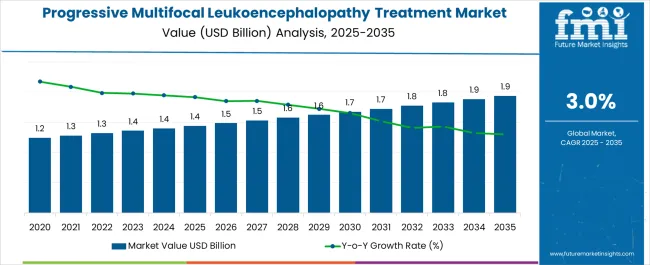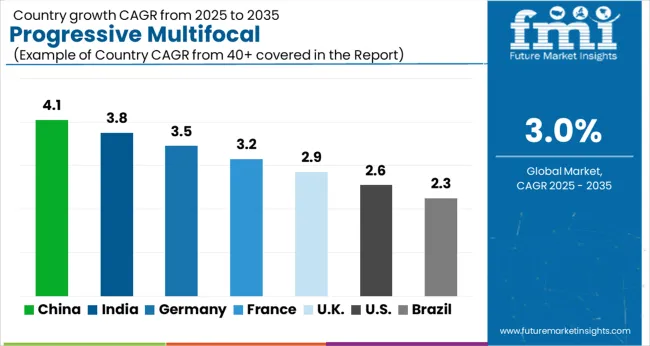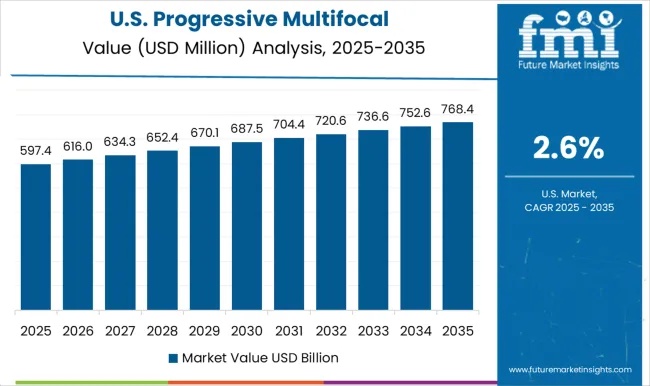The Progressive Multifocal Leukoencephalopathy Treatment Market is estimated to be valued at USD 1.4 billion in 2025 and is projected to reach USD 1.9 billion by 2035, registering a compound annual growth rate (CAGR) of 3.0% over the forecast period.

| Metric | Value |
|---|---|
| Progressive Multifocal Leukoencephalopathy Treatment Market Estimated Value in (2025 E) | USD 1.4 billion |
| Progressive Multifocal Leukoencephalopathy Treatment Market Forecast Value in (2035 F) | USD 1.9 billion |
| Forecast CAGR (2025 to 2035) | 3.0% |
The progressive multifocal leukoencephalopathy treatment market is expanding due to the rising prevalence of immunocompromised conditions, including HIV and patients undergoing immunosuppressive therapies. Advancements in antiretroviral therapy, improved diagnostic accuracy, and increased awareness among clinicians are contributing to early detection and timely intervention.
Hospital infrastructure improvements and wider accessibility to treatment in developed and emerging economies are supporting adoption. Additionally, ongoing research into novel therapeutic approaches and supportive care strategies is strengthening clinical outcomes.
Regulatory support for rapid drug approvals and healthcare investments in neurological disorder management are expected to provide long term growth opportunities. The overall outlook is positive, with demand being reinforced by the need to address life threatening complications associated with immunosuppression and opportunistic infections.
The anti-retroviral therapy segment is projected to contribute 54.20% of total market revenue by 2025 within the treatment category, establishing it as the leading treatment option. This dominance is driven by the effectiveness of antiretroviral combinations in restoring immune function and reducing the viral triggers associated with progressive multifocal leukoencephalopathy.
Widespread adoption in HIV care protocols and availability through structured healthcare programs have further enhanced uptake.
Continued innovation in antiretroviral regimens with improved safety and efficacy profiles has sustained its leadership in the treatment segment.
The hospital pharmacies segment is expected to hold 48.60% of overall revenue by 2025 within the distribution channel category, positioning it as the leading channel. This is attributed to the critical role hospital settings play in managing immunocompromised patients and providing access to advanced therapies.
Availability of specialized care, integrated treatment protocols, and immediate access to medications for severe cases have reinforced the preference for hospital pharmacies.
In addition, hospital based distribution ensures proper monitoring of drug interactions and patient adherence, further strengthening this channel’s prominence.
The HIV/AIDS segment is anticipated to account for 46.70% of total revenue by 2025 within the indication category, making it the most significant contributor. This is largely due to the strong correlation between immunodeficiency caused by HIV and the onset of progressive multifocal leukoencephalopathy.
High global prevalence of HIV and the critical need for effective therapeutic interventions have underpinned growth in this segment. Expanded screening programs, access to antiretroviral therapies, and awareness campaigns have further supported early intervention.
As a result, HIV/AIDS remains the dominant indication segment, reinforcing its central role in driving market expansion.
According to market research and competitive intelligence provider, Future Market Insights- the market for progressive multifocal leukoencephalopathy treatment reflected a value of 2% during the historical period, 2020 to 2025.
The market for Progressive Multifocal Leukoencephalopathy Treatment is gaining prominence as it is considered a rare, life-threatening brain disease caused by the JC virus. Furthermore, due to the rarity of the disease, there is ongoing research into developing new treatments for PML, expected to drive demand for these treatments.
The development of new PML treatments is a high priority for the medical community due to the devastating effects of the disease and the limited treatment options available. As more effective treatments become available, the market for PML treatment is likely to grow. In the years to come, increasing focus by government organizations and private agencies like WHO and pharmaceutical companies to create awareness of Progressive Multifocal Leukoencephalopathy Treatments is fuelling the market growth. Thus, the market for progressive multifocal leukoencephalopathy treatment is expected to register a CAGR of 3% in the forecast period 2025 to 2035.
Growing advancements in diagnostic and treatment options to push the market growth
The global market for progressive multifocal leukoencephalopathy treatment is primarily driven by the incidence of blood cancers, including multiple myeloma, the development of new and effective treatment options, advancements in treatment technologies and development of new diagnostic technologies and the availability of more effective treatments. According to the latest studies, PML occurs in approximately one in 200,000 people. As per the same report, each year, it is estimated that 4,000 people develop PML in the United States and Europe combined.
The growth of the progressive multifocal leukoencephalopathy treatment market is owed to the increasing prevalence of the condition owing to the increasing use of immunosuppressive drugs for autoimmune and other conditions. As a result, the players in the market are working on the development of new diagnostic tools and imaging techniques that are likely to improve the accuracy of Progressive Multifocal Leukoencephalopathy diagnosis.
For instance, in November 2024, Japan approved the world's first oncolytic virus-based immunotherapy called Teserpaturev, bringing new hope to individuals struggling with a malignant brain tumor known as GBM. Teserpaturev is a genetically engineered herpes simplex virus type 1 (HSV-1) that boasts a unique capability of not only killing the brain tumor cells it infects, but also those that have spread to other parts of the brain. This is achieved by activating a patient's own immune system to fight the tumor.
Expensive Cost of Treatment to restrict Market Growth
The market is projected to get significantly affected by the challenging factors such as limited availability and high cost of advanced Progressive Multifocal Leukoencephalopathy Treatment options. Expensive treatments and related costs such as hospitalization, intensive care, or specialized diagnostic tests, is expected to hinder the market growth. Furthermore, poor healthcare infrastructure, especially in developing countries, can limit access to Progressive Multifocal Leukoencephalopathy Treatment and the availability of diagnostic and therapeutic options.

Improvement in healthcare spending propelling growth of the regional markets
The South and East Asia is expected to exhibit the significant growth rate of all regions over the forecast period, with a share of 20% during the forecast period. The growth is owed to increased awareness, significant increases in healthcare spending, and a rising frequency of the progressive multifocal leukoencephalopathy treatment in the region.
South Asia is an emerging market due to the increase in point of care approach to health & care. An increasing number of hospitals in India and China makes a promising market for the market worldwide.
Increasing Prevalence of Skin Conditions Shaping Landscape for Progressive Multifocal Leukoencephalopathy Treatment in North America

North America is anticipated to acquire a market share of about 40% in the forecast period. This growth is attributable to the rising prevalence of the condition in the region along with the high healthcare expenditure and a large geriatric population.
The United States of America holds the highest share in the North American market, followed by Canada. Presence of a large number of pharmaceutical companies, which are investing heavily in the development of new, targeted treatments for the condition, high level of healthcare expenditure and the high incidence of PML leading to a large patient population are some of the factors responsible for the growth of the market in the region.
Rising prevalence of HIV infection to push market growth
According to the studies, 38 million people worldwide are currently living with HIV or AIDS. The increasing incidence of HIV infection in many middle- and low-income countries is projected to drive the growth of the market for progressive multifocal leukoencephalopathy treatment over the forecast period.
Favorable reimbursement policies for both HIV and cancer treatment are expected to further drive the growth of the progressive multifocal leukoencephalopathy market over the forecast period.
Hospital pharmacies to take the lead and drive market growth
According to the FMI analysis, Hospital pharmacy accounts for the largest market share. The requirement for several hospital stays and visits during the progressive multifocal leukoencephalopathy treatment facilitates the growth of this segment. The majority of the serious venous diseases involving the brain are treated in hospitals, and with the availability of trained medical personnel, it is simpler to control an individual's health more correctly.

Key players in the market include pharmaceutical companies such as NeoImmuneTech, Neurimmune, GlaxoSmithKline Plc, Sanofi S.A., Gilead Sciences, Inc., Allergan Plc., Novartis AG, AbbVie Inc., and Bristol-Myers Squibb Company along with healthcare providers and technology companies among other global players.
| Report Attribute | Details |
|---|---|
| Market Value in 2025 | USD 1.4 billion |
| Market Value in 2035 | USD 1.9 billion |
| Growth Rate | CAGR of 3% from 2025 to 2035 |
| Base Year for Estimation | 2025 |
| Historical Data | 2020 to 2025 |
| Forecast Period | 2025 to 2035 |
| Quantitative Units | Revenue in USD Million and CAGR from 2025 to 2035 |
| Report Coverage | Revenue Forecast, Volume Forecast, Company Ranking, Competitive Landscape, Growth Factors, Trends and Pricing Analysis |
| Segments Covered | Treatment, Indication, Distribution Channel, Region |
| Regions Covered | North America; Latin America; Europe; South Asia; East Asia; Oceania; Middle East & Africa |
| Key Countries Profiled | United States, Canada, Brazil, Mexico, Germany, United Kingdom, France, Spain, Italy, India, Malaysia, Singapore, Thailand, China, Japan, South Korea, Australia, New Zealand, GCC Countries, South Africa, Israel |
| Key Companies Profiled | NeoImmuneTech; Inhibikase Therapeutics; Neurimmune; Pfizer Inc.; GSK Plc; Sanofi S.A.; Gilead Sciences Inc.; Allergan Plc.; Novartis AG; F. Hoffmann-La Roche Ltd.; AbbVie Inc.; Bristol-Myers Squibb Company |
| Customization | Available Upon Request |
The global progressive multifocal leukoencephalopathy treatment market is estimated to be valued at USD 1.4 billion in 2025.
The market size for the progressive multifocal leukoencephalopathy treatment market is projected to reach USD 1.9 billion by 2035.
The progressive multifocal leukoencephalopathy treatment market is expected to grow at a 3.0% CAGR between 2025 and 2035.
The key product types in progressive multifocal leukoencephalopathy treatment market are anti-retroviral therapy, antiviral/anti jcv and other symptomatic.
In terms of distribution channel, hospital pharmacies segment to command 48.6% share in the progressive multifocal leukoencephalopathy treatment market in 2025.






Full Research Suite comprises of:
Market outlook & trends analysis
Interviews & case studies
Strategic recommendations
Vendor profiles & capabilities analysis
5-year forecasts
8 regions and 60+ country-level data splits
Market segment data splits
12 months of continuous data updates
DELIVERED AS:
PDF EXCEL ONLINE
Progressive Pulmonary Fibrosis (PPF) Treatment Market - Growth & Innovations 2025 to 2035
Progressive Fibrosing Interstitial Lung Disease (PF-ILD) Treatment Market – Growth & Future Outlook 2025 to 2035
Treatment-Resistant Hypertension Management Market Size and Share Forecast Outlook 2025 to 2035
Treatment-Resistant Depression Treatment Market Size and Share Forecast Outlook 2025 to 2035
Treatment Pumps Market Insights Growth & Demand Forecast 2025 to 2035
Pretreatment Coatings Market Size and Share Forecast Outlook 2025 to 2035
Air Treatment Ozone Generator Market Size and Share Forecast Outlook 2025 to 2035
CNS Treatment and Therapy Market Insights - Trends & Growth Forecast 2025 to 2035
Seed Treatment Materials Market Size and Share Forecast Outlook 2025 to 2035
Acne Treatment Solutions Market Size and Share Forecast Outlook 2025 to 2035
Scar Treatment Market Overview - Growth & Demand Forecast 2025 to 2035
Soil Treatment Chemicals Market
Water Treatment System Market Size and Share Forecast Outlook 2025 to 2035
Water Treatment Chemical Market Size and Share Forecast Outlook 2025 to 2035
Algae Treatment Chemical Market Forecast and Outlook 2025 to 2035
Water Treatment Market Size and Share Forecast Outlook 2025 to 2035
Water Treatment Ozone Generator Market Size and Share Forecast Outlook 2025 to 2035
Water Treatment Equipment Market Size and Share Forecast Outlook 2025 to 2035
Burns Treatment Market Overview – Growth, Demand & Forecast 2025 to 2035
CRBSI Treatment Market Insights - Growth, Trends & Forecast 2025 to 2035

Thank you!
You will receive an email from our Business Development Manager. Please be sure to check your SPAM/JUNK folder too.
Chat With
MaRIA